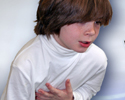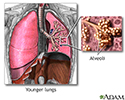Bronchiolitis
Respiratory syncytial virus - bronchiolitis; Flu - bronchiolitis; Wheezing - bronchiolitisBronchiolitis is swelling and mucus buildup in the smallest air passages in the lungs (bronchioles). It is usually due to a viral infection.
Causes
Bronchiolitis usually affects children under the age of 2, with a peak age of 3 to 6 months. It is a common, and sometimes severe illness. Respiratory syncytial virus (RSV) is the most common cause. More than half of all infants are exposed to this virus by their first birthday.
Respiratory syncytial virus
Respiratory syncytial virus (RSV) is a very common virus that leads to mild, cold-like symptoms in adults and older healthy children. It can be more...

Other viruses that can cause bronchiolitis include:
- Adenovirus
-
Influenza
Influenza
The flu (influenza) is a viral respiratory illness that causes fever, chills, runny nose, body aches, and cough. It spreads easily from person to pe...
 ImageRead Article Now Book Mark Article
ImageRead Article Now Book Mark Article -
Parainfluenza
Parainfluenza
Parainfluenza refers to a group of viruses that lead to upper and lower respiratory infections.
Read Article Now Book Mark Article
The virus is spread to infants by coming into direct contact with nose and throat fluids of someone who has the illness. This can happen when another child or an adult who has a virus:
- Sneezes or coughs nearby and tiny droplets in the air are then breathed in by the infant
- Touches toys or other objects that are then touched by the infant
Bronchiolitis occurs more often in the fall and winter than other times of the year. It is a very common reason for infants to be hospitalized during winter and early spring.
Risk factors of bronchiolitis include:
- Being around cigarette smoke
- Being younger than 6 months old
- Living in crowded conditions
- Not being breastfed
- Being born before 37 weeks of pregnancy
Symptoms
Some children have few or mild symptoms.
Bronchiolitis begins as a mild upper respiratory infection. Within 2 to 3 days, the child develops more breathing problems, including wheezing and a cough.
Wheezing
Wheezing is a high-pitched whistling sound during breathing. It occurs when air moves through narrowed breathing tubes in the lungs.

Symptoms include:
-
Bluish skin due to lack of oxygen (cyanosis) - emergency treatment is needed
Bluish skin
A bluish color to the skin or mucous membrane is usually due to a lack of oxygen in the blood. The medical term is cyanosis.
 ImageRead Article Now Book Mark Article
ImageRead Article Now Book Mark Article - Breathing difficulty including wheezing and shortness of breath
- Cough
- Fatigue
- Fever
- Muscles around the ribs sink in as the child tries to breathe in (called intercostal retractions)
Intercostal retractions
Intercostal retractions occur when the muscles between the ribs pull inward. The movement is most often a sign that the person has a breathing probl...
 ImageRead Article Now Book Mark Article
ImageRead Article Now Book Mark Article - Infant's nostrils get wide when breathing
- Rapid breathing (tachypnea)
Exams and Tests
Your health care provider will perform a physical exam. Wheezing and crackling sounds may be heard through the stethoscope.
Most of the time, bronchiolitis can be diagnosed based on the symptoms and the exam.
Tests that may be done include:
-
Blood gases
Blood gases
Blood gases are a measurement of how much oxygen and carbon dioxide are in your blood. They also determine the acidity (pH) of your blood.
 ImageRead Article Now Book Mark Article
ImageRead Article Now Book Mark Article -
Chest x-ray
Chest x-ray
A chest x-ray is an x-ray of the chest, lungs, heart, large arteries, ribs, and diaphragm.
 ImageRead Article Now Book Mark Article
ImageRead Article Now Book Mark Article - Culture of a sample of nasal fluid to determine the virus causing the disease
Treatment
The main focus of treatment is to relieve symptoms, such as difficulty breathing and wheezing. Some children may need to stay in the hospital if their breathing problems do not improve after being observed in the clinic or emergency room.
Antibiotics do not work against viral infections. Medicines that treat viruses may be used to treat very ill children.
At home, measures to relieve symptoms can be used. For example:
At home, measures to relieve symptoms
Your child has bronchiolitis, which causes swelling and mucus to build up in the smallest air passages of the lungs. Now that your child is going hom...

- Have your child drink plenty of fluids. Breast milk or formula is fine for children younger than 12 months. Electrolyte drinks, such as Pedialyte, are also OK for infants.
- Have your child breathe moist (wet) air to help loosen sticky mucus. Use a humidifier to moisten the air.
- Give your child saline nose drops. Then use a nasal suction bulb to help relieve a stuffy nose.
- Be sure your child gets plenty of rest.
Do not allow anyone to smoke in the house, car, or anywhere near your child. Children who are having trouble breathing may need to stay in the hospital. There, treatment may include oxygen therapy and fluids given through a vein (IV).
Outlook (Prognosis)
Breathing often gets better by the third day and symptoms mostly clear within a week. In rare cases, pneumonia or more severe breathing problems develop.
Pneumonia
Pneumonia is a lung infection caused by bacteria, viruses, or fungi. This article covers community-acquired pneumonia (CAP) in children. This type o...

Some children may have problems with wheezing or asthma as they get older.
When to Contact a Medical Professional
Contact your provider right away or go to the emergency room if your child:
- Becomes extremely tired
- Has bluish color in the skin, nails, or lips
- Starts breathing very fast
- Has a cold that suddenly worsens
- Has difficulty breathing
- Has nostril flaring or chest retractions when trying to breathe
Prevention
Most cases of bronchiolitis cannot be prevented because the viruses that cause the infection are common in the environment. Careful hand washing, especially around infants, can help prevent the spread of viruses.
A medicine called palivizumab (Synagis) that boosts the immune system may be recommended for certain children. Your child's provider will let you know if this medicine is right for your child.
References
House SA, Ralston SL. Wheezing, bronchiolitis, and bronchitis. In: Kliegman RM, St. Geme JW, Blum NJ, Shah SS, Tasker RC, Wilson KM, eds. Nelson Textbook of Pediatrics. 21st ed. Philadelphia, PA: Elsevier; 2020:chap 418.
Ralston SL, Lieberthal AS; American Academy of Pediatrics, et al. Clinical practice guideline: the diagnosis, management, and prevention of bronchiolitis. Pediatrics. 2014;134(5):e1474-e1502. PMID: 25349312 pubmed.ncbi.nlm.nih.gov/25349312/.
Walsh EE, Englund JA. Respiratory syncytial virus. In: Bennett JE, Dolin R, Blaser MJ, eds. Mandell, Douglas, and Bennett's Principles and Practice of Infectious Diseases. 9th ed. Philadelphia, PA: Elsevier; 2020:chap 158.
-
What causes wheezing?
Animation
-
Bronchiolitis - illustration
Bronchiolitis is an inflammation of the bronchioles (smaller airways that branch off the main airway) usually caused by a viral infection.
Bronchiolitis
illustration
-
Normal lungs and alveoli - illustration
The lungs are located in the chest cavity and are responsible for respiration. The alveoli are small sir sacs where oxygen is exchanged in the lungs.
Normal lungs and alveoli
illustration
-
Bronchiolitis - illustration
Bronchiolitis is an inflammation of the bronchioles (smaller airways that branch off the main airway) usually caused by a viral infection.
Bronchiolitis
illustration
-
Normal lungs and alveoli - illustration
The lungs are located in the chest cavity and are responsible for respiration. The alveoli are small sir sacs where oxygen is exchanged in the lungs.
Normal lungs and alveoli
illustration
Review Date: 8/5/2023
Reviewed By: Neil K. Kaneshiro, MD, MHA, Clinical Professor of Pediatrics, University of Washington School of Medicine, Seattle, WA. Also reviewed by David C. Dugdale, MD, Medical Director, Brenda Conaway, Editorial Director, and the A.D.A.M. Editorial team.





